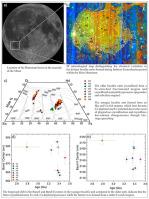当前位置:
X-MOL 学术
›
Planet. Space Sci.
›
论文详情
Our official English website, www.x-mol.net, welcomes your feedback! (Note: you will need to create a separate account there.)
Pyroxene chemistry and crystallization history of basaltic units in the Mare Humorum on the nearside Moon: Implications for the volcanic history of the region
Planetary and Space Science ( IF 2.4 ) Pub Date : 2020-11-01 , DOI: 10.1016/j.pss.2020.105093 P.M. Thesniya , V.J. Rajesh
Planetary and Space Science ( IF 2.4 ) Pub Date : 2020-11-01 , DOI: 10.1016/j.pss.2020.105093 P.M. Thesniya , V.J. Rajesh

|
Abstract Mare basalts are volcanic features on the lunar surface and are vital for understanding the Moon's volcanic and thermal history. The present study investigates the mineralogy and chemical variations of the mare basaltic units in the Mare Humorum on the Moon's nearside using orbital remote sensing data from recent lunar exploration missions. The previous model ages available for the Humorum basaltic units have been utilized in the present study to understand the chemical evolution of these basaltic units with time. Basalts of Imbrian-Eratosthenian periods occur in the Mare Humorum. Hyperspectral data from Moon Mineralogy Mapper onboard Chandrayaan-1 mission showed pigeonites and augites as the major compositions in these basaltic units. The compositional trend between pigeonites and augites point towards the differentiation of the basaltic magma while cooling. The older units crystallized from a Fe-enriched fractionated magma while the younger unit formed from an Mg and Ca-rich magma. These distinct chemical trends in the pyroxene quadrilateral revealed that multiple volcanic eruptions have occurred in the Mare Humorum. The longward and shortward shifts in the Band I and Band II centres in the younger and older basalts respectively, also indicate that the older basaltic units crystallized more Fe2+-rich, Ca-depleted pyroxenes while the younger basaltic unit was formed from a rather calcium-rich magma. Hence, it has been concluded that the basaltic magma erupted in the Mare Humorum during Imbrian and Eratosthenian periods were derived from heterogeneous source regions.
中文翻译:

近侧月球 Mare Humorum 玄武质单元的辉石化学和结晶历史:对该地区火山历史的影响
摘要 Mare 玄武岩是月球表面的火山特征,对于了解月球的火山和热历史至关重要。本研究利用近期月球探测任务的轨道遥感数据,研究了月球近侧 Mare Humorum 中玄武岩单元的矿物学和化学变化。Humorum 玄武岩单元可用的先前模型年龄已用于本研究,以了解这些玄武岩单元随时间的化学演变。雨海-埃拉托森纪的玄武岩出现在 Mare Humorum 中。来自月船一号任务上的月球矿物测绘仪的高光谱数据显示,这些玄武岩单元中的主要成分是辉石和辉石。变质岩和辉石之间的成分趋势指向玄武岩岩浆在冷却过程中的分化。较老的单元从富含铁的分馏岩浆中结晶出来,而较新的单元则由富含镁和钙的岩浆形成。辉石四边形中这些不同的化学趋势表明,在 Mare Humorum 中发生了多次火山喷发。较年轻和较老玄武岩中带 I 和带 II 中心的长向和短移分别表明,较老的玄武岩单元结晶出更多富含 Fe2+、Ca 贫化的辉石,而较年轻的玄武岩单元由相当钙质的辉石形成。丰富的岩浆。因此,可以得出结论,在雨海纪和埃拉托斯特纪期间在体海喷发的玄武质岩浆来自异质源区。
更新日期:2020-11-01
中文翻译:

近侧月球 Mare Humorum 玄武质单元的辉石化学和结晶历史:对该地区火山历史的影响
摘要 Mare 玄武岩是月球表面的火山特征,对于了解月球的火山和热历史至关重要。本研究利用近期月球探测任务的轨道遥感数据,研究了月球近侧 Mare Humorum 中玄武岩单元的矿物学和化学变化。Humorum 玄武岩单元可用的先前模型年龄已用于本研究,以了解这些玄武岩单元随时间的化学演变。雨海-埃拉托森纪的玄武岩出现在 Mare Humorum 中。来自月船一号任务上的月球矿物测绘仪的高光谱数据显示,这些玄武岩单元中的主要成分是辉石和辉石。变质岩和辉石之间的成分趋势指向玄武岩岩浆在冷却过程中的分化。较老的单元从富含铁的分馏岩浆中结晶出来,而较新的单元则由富含镁和钙的岩浆形成。辉石四边形中这些不同的化学趋势表明,在 Mare Humorum 中发生了多次火山喷发。较年轻和较老玄武岩中带 I 和带 II 中心的长向和短移分别表明,较老的玄武岩单元结晶出更多富含 Fe2+、Ca 贫化的辉石,而较年轻的玄武岩单元由相当钙质的辉石形成。丰富的岩浆。因此,可以得出结论,在雨海纪和埃拉托斯特纪期间在体海喷发的玄武质岩浆来自异质源区。



























 京公网安备 11010802027423号
京公网安备 11010802027423号